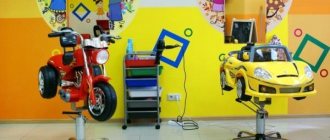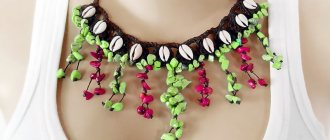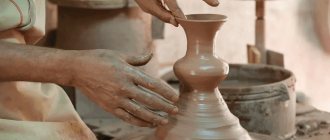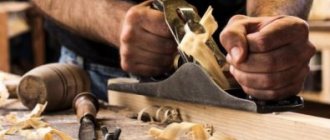Types of modeling clay
Before you begin to master the art of modeling, you need to get acquainted with the material. There are two types of clay:
- purchased;
- natural.
For beginners, purchased material is better suited. It is packaged in one and a half kilogram bags and sold in art supply departments. You should pay attention when purchasing that the packaging is vacuum sealed. In production, clay is prepared using special equipment that removes air from the clay structure. Air bubbles make the product fragile. Undamaged vacuum packaging indicates a quality product.
Natural clay is taken from the environment - in the nearest park, in a vegetable garden, on the shore of a reservoir. The extracted clay is not suitable for modeling; it is saturated with impurities and crumbles.
To clean natural material, you need to immerse it in a container of warm water and leave it for a day. Impurities have a greater weight relative to clay, so they will gradually settle to the bottom. A fatty layer will appear on the surface of the liquid, which must be strained through cheesecloth. The resulting mass is left in the air and wait until it thickens to the desired consistency. After the preparatory procedures, natural clay is ready for work.
Varieties of polymer clays
Today you can find polymer clay from different manufacturers on sale, but only a certain brand is suitable for each type of decorative crafts. For beginners, it is better to buy domestic plastic, it is much cheaper than imported analogues. In addition, Polish and Chinese materials are suitable, with which you can easily master the basics and various techniques without worrying about the budget.
Of the domestic materials, the most acceptable option is polymer clay “Tsvetik”, it is sold in packages of 6 or 12 shades. Among the disadvantages of the polymer, we should note the fragility of the finished craft after drying, a small selection of colors and the lack of interesting effects.
Set “Flower” of 12 shades
Polymer clay is the most popular; craftsmen appreciate the huge selection of shades that do not change after firing. In addition, it is suitable for almost all techniques.
Polymer clay "Fimo"
Another easy-to-sculpt material, it has excellent plasticity. Masters note that its consistency is a bit like wax. Thanks to this, the polymer makes excellent sausage-shaped products.
Premo set
For professionals working in artistic modeling techniques, the Cernit brand is suitable. Craftsmen note excellent density indicators, along with a waxy structure, thanks to which it is possible to create small elements and amazing shapes. One of the disadvantages is the change in color after firing, up to the appearance of a transparent effect.
Variety of Cernit shades Kato brand plastic is used in professional settings, since it requires higher temperatures to harden. It has a hard consistency and requires a hammer to soften it.
Plastic brand “Kato”
Professionals advise beginners to work with each material to decide which one is more convenient to work with.
Fluorescent clay "Sonnet"
Related article:
Epoxy resin for creativity : properties, composition, characteristics, selection of the right components and options for using different solvents and plasticizers, instructions for use and an overview of current prices - read in the publication.
Rules for storing clay
Without moisture, clay becomes dry and unsuitable for work. To preserve its plastic properties, you need to wrap it in a damp cloth, place it in a plastic bag and store it in the refrigerator. If the clay reserves are too large, then a dark cellar is suitable for storage. To prevent mold from forming inside the package, the clay must be periodically removed and ventilated.
Magic clay
Children enjoy making toys from clay: it adheres perfectly, and you can apply layer after layer. Professionals create unique dolls.
Clay is universal and plastic. The only negative is that when fired, harmful components are released from it. But you’re not going to burn monumental creations, are you? Therefore, let clay into your home. You will not regret. There will be something to do on long winter evenings.
Tools and related materials for modeling
Experienced craftsmen use tools that make their work easier and make the creative process enjoyable and comfortable.
These include:
- a metal string of medium thickness allows you to separate pieces of precise size from a large mass;
- a safety knife with a short working part for separating small pieces of material;
- wooden board for rolling out clay;
- wooden rolling pin;
- woven fabrics with a rough relief pattern that would be well imprinted on clay;
- stacks;
- foam sponge;
- various household little things that can be useful in decorating crafts.
As a knife, it is convenient to use the blade from an old kitchen knife, wrapped with electrical tape in the handle area. This uncomplicated, simple tool is considered safe, it is convenient for separating small pieces of clay, while the edges on the cutting line remain smooth. Plastic knives are not suitable; they are flexible, fragile and tear the edges. Stationery knives are too sharp and dangerous.
The principle of working with polymer clay
Before work you need to prepare a hard surface. Ideally, this could be a sheet of glass or tile. Wood is not entirely suitable here, since you will have to use a knife in the work. As a last resort, you can take thick cardboard and cover it with white paper.
Working with the material is very simple; just knead a piece of the desired size in your hands. Gradually it will become soft. To impart plasticity, you should use a plasticizer. Finished crafts are placed in an oven or kiln for firing, after which they are sanded, polished and varnished.
You should know this! When preparing the material, there should be no air bubbles left in it, which expand under the influence of temperature, deforming the product.
Professional tool set
Firing clay products
Working with any plastic material is approximately the same. Only the final processing is different. In the case of clay, to give the products a finished look, they need to be fired at a temperature of 800-900 degrees in muffle furnaces. With this temperature exposure, the clay mass becomes ceramic. Only thoroughly dry items should be placed in the oven, otherwise they may explode.
Household devices such as microwave ovens and gas ovens are not suitable for firing. The craft market offers special clay that does not require firing at high temperatures.
If you really want to create a clay product in the traditional way, then you can try the artisanal firing method. Naturally, subject to all fire safety measures. To do this, dig a shallow hole in the ground, place a figurine on the bottom, build a fire on top and keep it burning intensely for 10 hours. The more the figurine is fired, the better quality it will turn out.
To understand how high quality the finished product is, just lightly tap on the ceramic surface. A ringing sound indicates successful processing; a dull sound indicates that the firing took too little time.
Tools needed for sculpting
To create masterpieces from polymer clay, you need to prepare a place and tools. It is important that all tools after modeling are not used for cooking, but it is better to leave them only for making crafts:
- board on which products will be made;
- knives, wooden sticks, wire;
- rolling pin, empty bottle, pasta machine;
- molds;
- materials for decoration (beads, beads, sequins, lace, foil, fasteners, chains, etc.)
- gloves;
- napkins;
- sandpaper or file for sanding;
- acrylic paints, varnish;
- baking dishes.
When creating products, you must adhere to several rules:
- Wear gloves.
- Use wooden, glass, metal utensils and tools.
- After finishing work, remove the remaining dough into a bag and into the refrigerator.
- Wash and dry the tools, put them away until next time.
- Avoid getting clay on surfaces: floor, carpet.
It is important to remember that during drying the product decreases in size, so in order to obtain the required final size, the figurine must be made a little larger.
Easy clay crafts
On Internet resources you can find many photos of clay crafts, differing in the complexity of their implementation. Once inspired by ideas, you can create beautiful products. Some of them are quite simple, even a child can do it.
Magnet for needles
A needle magnet is useful in everyday life. To create it you will need:
- rolling pin;
- form;
- clay with self-hardening properties;
- gouache and brush;
- lace ribbon;
- a piece of sandpaper;
- 2 small magnets;
- glue.
The master class should begin with thoroughly kneading the clay mass. The next steps are:
- Roll out a piece of clay into a flat cake;
- Cut out the desired outline using a mold;
- Trim the edges;
- Press the lace into the surface to give it an interesting texture;
- Wait for the product to dry;
- Sand it with sandpaper to remove any irregularities;
- Apply patterns with paint and decorate to taste;
- Glue the magnet to the back.
The needle magnet is ready. Craftswomen appreciate this accessory. The magnet is attached to the hoop. It allows you not to lose needles that are in use.
Flowers
Clay flowers look interesting. The material has high plasticity, which allows you to create thin petals that are indistinguishable from real ones. To make a rose, a medium-sized clay ball is shaped into a drop. It will act as the core of the inflorescence.
Next, thin cakes are made from several pre-prepared balls and petals are formed. The petals are stacked on top of each other around a teardrop-shaped core, gradually creating a bud. The outer petals are slightly curved to give a believable appearance. The final stage is painting and decorating.
Food made from polymer clay
Trying to involve children in modeling, parents often create vegetables and fruits from polymer clay with them. By being creative, young masters learn about the world around them, develop fantasy, imagination, memory, and fine motor skills. Clay vegetables and fruits can be used as food in doll games. For example, to make an orange, you need to give the surface of the ball the appearance of a real “peel” using a toothpick. A thin leaf is stuck onto the apple and veins are drawn on it.
Gradually, the child masters a variety of modeling techniques. Parents and teachers need to take into account the children’s desire to see results quickly. To avoid disappointment and loss of interest in creativity, they need to be explained that the product does not take on a finished form right away.
Modeling with polymer clay is a fun activity for the whole family. Handmade toys, souvenirs, and gifts radiate kindness, comfort and originality. The range of possibilities is not limited to simple crafts. Experienced craftsmen create real works of art using polymer clay that will not be embarrassing to decorate the interior of a room.
Clay business: how to make money teaching pottery
To buy a kiln for firing clay products, Alexey Belousov and Alena Shoiko from Novosibirsk sold their car. Such an “exchange” opened the way for them to their own ceramics workshop - so they have never regretted the car since then. As well as the fact that they left their paid jobs and became entrepreneurs. The founders of the Formo studio told the Biz360 portal about how to stand out among competitors and why they relied not on product release, but on training.
Dossier
Alena Shoiko
, 26 years;
Alexey Belousov
, 32 years old;
entrepreneurs from Novosibirsk, founders of the Formo
. Alena graduated from the Siberian Academy of Public Administration (Faculty of Psychology), Alexey graduated from the University of Consumer Cooperatives (specialty in crisis management). The Formo workshop opened in October 2020.
Sold a car, bought a stove
Alexey Belousov never thought that he would become a potter. Before that, he worked on various projects in completely different areas - from marketing campaigns to creating his own franchise. But Alena Shoiko dreamed of ceramics since childhood. It was she who convinced Alexey to open a workshop.
“I always studied everything I could find about ceramics, then I got into a children’s circle and stayed there for an indecently long time - I became too old for the circle, but I still went. I was able to start working on a pottery wheel only a few years ago. I studied privately and immediately with a serious goal - to position my hands correctly. Then I worked as a pottery teacher myself, and then I had my own circle. And since I installed it at home, Alexey, of course, tried it - and also fell in love with this activity. Now he is so practiced that he will give me a head start. And this is great, after all, potter is a male profession.”
“For a long time my life was connected with computers. In the end, I decided that I wanted to move from the virtual to something real, tangible,” explains Alexey. “If I was primarily interested in money, I would hardly take up pottery – it’s not the most profitable business in the world.”
At the same time, entry into this not the most profitable business today is not cheap. The main tool of a ceramist - a kiln for firing clay products - cost the beginners from Novosibirsk 250 thousand rubles. The potter's wheel cost another 80 thousand. To buy a stove, Alena and Alexey sold their car.
“In the Papa Johns pizzeria next to our workshop there is a poster that says that the creator sold his favorite car to open his own business and buy the first oven. This phrase amused us, because we had a similar story,” says Alexey. – I must say, we were lucky: we were able to buy very high-level equipment second-hand, although such models are usually difficult to find on the secondary market. We also purchased our car by accident at one time on favorable terms. We then doubted whether we needed it at all. But, as it now turns out, if it weren’t for the car, there would be no stove – and no workshop.”
“It was immediately clear to us that investing in equipment is an investment in the future,” adds Alena. “That’s why we didn’t try to make do with a homemade wheel and kiln, as some beginning potters do, but immediately bought quality ones.”
“I am forming”, “we are forming”...
At first, Alena and Alexey were going to make a workshop for personal creativity. Therefore, the kiln was sent to the balcony, and the pottery wheel settled in the room of their apartment. But it soon became clear that living like this was inconvenient. “It’s not just about equipment. You also need to order clay (you can’t buy it in Novosibirsk, so we buy it in Spain and Ukraine). You must always order in large quantities, and then store it somewhere,” explains Alena.
They started looking for a separate area for the stove - and eventually came to the Formo space with master classes on clay modeling. It is they who today occupy 70% of Alexey and Alena’s working time – and have set them apart from other similar organizations.
Before ceramics, Alena was a photographer for six years, and also taught dancing, various types of needlework and, in fact, pottery. Alexey had experience in design and photography. All this ended up being very useful in their new business.
“My education as a psychologist also helped. I communicate with people a lot now, but here I can’t live without psychology,” says Alena.
The name came to the minds of novice craftsmen by chance: from the word “shaping”. “Education” in this context is associated with master classes, and the word formo in Portuguese means “to form.” In addition to the semantic load, the name of the workshop also sounds modern and international.
According to Alexey, few competing workshops paid due attention to the name - and in vain. It can play a big role in scaling your business. In particular, when entering with your products at the federal and international level.
Loft residents
There are a number of special requirements for premises for a ceramic workshop - first of all, fire safety. You can’t go to an office center with such a project. However, Alexey and Alena were lucky again: pretty soon they found a site in the Novosibirsk loft Loft-Nsk in the city center. Formo started work on about 30 square meters, now it is located on 50.
The place required serious renovation. Basically Alexey did it himself. So, from a production room with ventilation shafts and openings for elevators, a workshop was turned into a workshop.
“It was scary to launch: it seemed to us that no one would come to the opening except our friends,” admits Alena. “But in the end, the loft itself provided us with information support. Plus the information spread across social networks. We didn’t run any special advertising there for the opening – we just hung up an announcement. As a result, there weren’t really any acquaintances at the opening, but mostly strangers came.”
Entrepreneurs immediately began offering master classes, which turned out to be in demand. Almost from the very opening, Formo attracted a large flow of people, and so far the entrepreneurs have not encountered any downtime. “We also immediately began to receive orders for dishes from Novosibirsk companies,” says Alexey. “So we started teaching classes and doing custom sculpting at the same time.”
Dates and birthdays with clay
A minimum of 100 kg of clay is used per month for lessons at Formo; it is ordered from various suppliers in Spain and Ukraine. At master classes, Alexey and Alena allow students to try different techniques of sculpting (by hand and on a pottery wheel) and applying glazes (dipping, watering, spraying with a spray bottle). The main goal of the studio’s creators is for guests to receive high-quality work, and not children’s crafts. After the classes, the products are fired, so that the participants then take home the finished ceramics of their own production.
The master class schedule for the week includes days when you can come and sculpt on a free theme, and there are at least three group thematic classes on hand sculpting. Individual pottery master classes are also held every day (in the near future, the studio will also begin conducting group classes on a circle). Modeling on a free theme is paid according to time: 400 rubles per hour for an adult, 300 for a child. A pottery wheel lesson for one person will cost 800 rubles, for a couple – 1200.
12 people can attend a group master class at the same time. But if necessary, the number can be increased to 30 (for example, for a corporate event). “The advantage of our loft is that we can rent additional space and conduct classes for a large audience,” says Alexey. “As far as I know, this is also one of our competitive advantages: many other studios do not have this opportunity.”
Families and couples often come to Formo, especially for the class aptly called “Pottery Wheel Date.” Also among the visitors are people who are simply interested in self-development and attend many courses and classes. In addition, the workshop offers a service for holding children's birthday parties.
Cup for the Greek
As for its products, for now this direction is being developed in the workshop rather on a residual basis - when there is time left free from teaching others. You can now buy Alexey and Alena’s products only in their small showroom at Formo.
They mainly create tableware. “Before the New Year, we tried to participate in the market with our products. And even about decorative garnet, which is very popular in the world of ceramics, people asked - how can it be used? That is, applied items are in great demand,” states Alena. — Dishes are interesting. Jewelry and figurines can be made from many other materials. And the dishes are mostly made only from clay.”
For the coming year, the creators of Formo have plans to develop their production line and establish online sales. Hopes are pinned on Instagram: according to Alexey’s observations, ceramics sell well there. Today, it is there and on VKontakte that the studio is promoting. Plus, the masters are going to open their own online store.
“While we are working together, we only have enough time for content for our main . And there’s not enough time to study and do things,” says Alena. “That’s why we only occasionally take orders for now.” But our team is already expanding, so we will soon develop this direction.”
Nevertheless, among these rare commissioned works, Formo masters already have a foreign one. Recently a musical group came to Novosibirsk, in which the keyboard player was from Greece. And this man from the homeland of pottery, where there are entire villages of ceramicists, ordered a cup from Formo. He collects them: he buys one in every city he visits.
There will be more potters
According to Alexey, his studio not only has competitors, but most likely there will be more. However, Formo has already reached a leading position in the city, because they seriously invested in the studio at every stage of work.
“There are people who worked before us for years, and yet in many ways we became pioneers,” says Alexey. — For example, not every workshop has a brand, but we tried to create one; Not everyone even has a website. We . Even if it’s still a C grade, it’s better to do it this way for now than to keep the perfect one in your head and not do it at all.”
As entrepreneurs say, they are lucky that they know how to teach, that is, train personnel themselves: in the near future they intend to expand the teaching staff. This is necessary to launch full-fledged courses in ceramics - for those who want not just to try themselves, but to learn this craft. Subsequently, the creators of Formo also plan to develop coworking space in their space.
“If you look at the Internet, it may seem that ceramics have become very popular and there are even too many offers,” summed up Alena. — But if we talk about specific cities, in reality this is not the case. New studios will probably appear in our city in the future.”
“Novosibirsk is big, and today you can count the potters in it on one hand – that’s why everyone has clients,” adds Alexey.
Useful tips
A few points to remember when working:
- Polymer clay has a specific smell when sculpting and baking, so you need to work with an open window.
- The figures must be made immediately and baked, because some types of clay can become brittle after drying in air or, on the contrary, lose their shape.
- Mix colors carefully using tables.
- The figures must be well connected, without leaving air streaks, since when baked, such a figure will crack or swell.
Modern craftsmen are developing many different techniques for sculpting and making figures. For a beginning craftsman, it is better to make simple, light figures from homemade clay.
What can be done
Thousands of different products can be made from polymer clay: accessories, jewelry, figurines, figurines and other items. Most often, it is used to make beads, earrings, rings, fairy-tale characters, animal figurines, keychains, flowers, mugs, and Christmas tree decorations.
You need to know that if the required color is not on sale, then it is allowed to mix it and get a variety of colors and shades.
Toys
To create a toy, you need to decide on the color and shape (volumetric or flat). For a flat figure (for example, a fish) you need:
- prepare a sketch drawn on thick paper or cardboard and cut it out;
- cut a piece and roll it out with a rolling pin;
- apply the clay to the cut out sketch and cut it with a knife;
- add eyes made of beads or small rolled clay circles to the figure, make scales with a knife, cutting out semicircles along the entire length of the fish.
After which the figurine should be wiped with a damp alcohol wipe, cleaning it.
Place in the oven to bake, then remove, dry and coat with acrylic varnish. Thus, you can make cartoon characters, gingerbread, a cat, a dog, Smeshariki, even buttons. Flat figures should be given a convex or wavy shape: for this it is necessary to lay the blanks on prepared foil figures.
Dolls
Doll to choose from: voluminous or flat. For a voluminous figure, roll out sausages and balls like plasticine.
Making a ball is the head.
The body must be made in the form of a cone, the arms and legs must be rolled into sausages.
You can make the feet and hands flat using a sketch and stick them to the sausages.
Next, thin sausages are rolled out, from which the doll's hair will be made. There is another way: roll out a flat oval shape, draw lines with a knife and stick it to the head.
Add a dress, a suit and a headdress, eyes made of beads or beads, a handbag, etc. to the finished doll.
New Year's crafts
To decorate the Christmas tree, you can make toys in the form of large and small balls, geometric shapes, Santa Claus, snowman, Snow Maiden, snowflake and others.
One of the options for crafts is combining several colors, using the example of a snowflake made of 2 colors (blue and white):
- Roll white into a thick sausage (cylinder).
- Roll out the blue flat cake and wrap it around the cylinder, cutting off the excess.
- Make another flat blue cake and cut into thin slices.
- Cut the cylinder in half and cut a blue strip along the edge of each, connecting the halves.
- Cut the cylinder in half again perpendicular to the first cut and stick it on, do this several times, when the cylinder sticks together, you will see that you have a kind of snowflake.
- Cut the cylinder into circles and place in the oven, then degrease and seal with varnish.
Before baking, you should use a toothpick to make holes in the snowflake so that later you have somewhere to thread the rope.
Figurines
The figurines are made in the likeness of a doll; you can combine colors or make one color and paint them after baking. For figurines, it will be necessary to make a pedestal on which the figurine is attached, so that it can then be placed and hung.
Mugs
Creating a mug or flower pot is a rather complicated process, for which you need to choose clay that is harder and dries quickly.
To make the figure even and beautiful, especially for beginners, you need to take a form - a plastic glass or a ready-made mug. Select the material and roll it out into large flat cakes, but not thin ones, 1-1.5 cm thick.
Grease the mold with vegetable oil or rinse with water.
Cover the mug from the inside, carefully connecting the layers of clay so that there are no cracks; ideally, it should be made from one whole piece.
Remove the figure and place it in the oven for baking, then degrease it with soapy water and seal it with varnish.
Flowers
Creating flowers is a kind of symphony in the form of a bouquet, keychain, earrings, or just a painting or a watch.
To create a rose, you need to roll out the plates, roll the first one into a tube, and gradually wrap the rest, straightening the petals. Chamomile is made from plates: blanks of paper with sharp or round edges and cut out the required amount from them.
Then combine and bake. You can create dahlias from balls that are cut in a circle with scissors, forming sharp petals, a little prickly, like those of a hedgehog.











